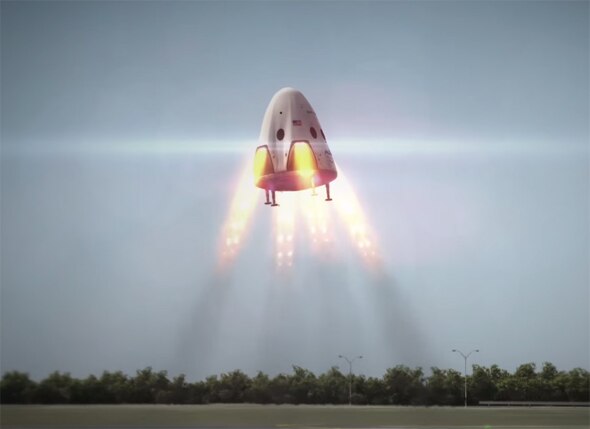Create a free profile to get unlimited access to exclusive videos, sweepstakes, and more!
SpaceX Will Test Its Launch Abort System Wednesday

Update, May 6, 2015, at 13:20 UTC: The test launch went off right on time, with the SuperDraco engines flinging the Dragon capsule high into the sky at 07:00 EDT. A minute or so later, it landed in the ocean under its parachutes. While the overall test looked successful I'm awaiting word about specifics; according to the flight plan sent out by SpaceX the trunk (the cylinder beneath the capsule) was also supposed to land in the water, but didn't, and the capsule wasn't as from the shore as I expected. It also tumbled for a few seconds near its flight apex, and I don't know if it was supposed to do that or not; that was quickly squelched when the parachutes deployed. Stay tuned.
If you want to launch astronauts in space, you have to make sure the procedure is as safe as possible. That’s why, for any launch system, NASA requires an abort procedure: a way to get the astronauts away from the rocket as quickly as possible if something goes wrong.
SpaceX is working on getting its Dragon capsule crew-rated, so it needs an abort system. A recent upgrade includes eight SuperDraco engines, set in pairs around its base. The idea is that if something catastrophic were to happen to the Falcon 9 rocket, the SuperDracos will fire to fling the capsule away.
They will put the engines to the test on Wednesday for a “pad abort test.” The Dragon will sit atop a truss to mimic the launch conditions on a Falcon 9 rocket. During the test, they’ll fire with 15,000 pounds of thrust each,* flinging the capsule about 1,600 meters up and over the Atlantic, where it will parachute down.† The capsule is loaded with sensors, including a human test dummy (which they named “Buster,” an obvious homage to the dummy from MythBusters). Update, May 5, 2015 at 14:30 UTC: I heard the dummy's name from several sources, but now SpaceX has sent out a press release, and included on it is the claim that the dummy's name is not Buster ("There will be a dummy on board the spacecraft, but despite popular belief, his name is not Buster. Buster the Dummy already works for a great show you may have heard of called MythBusters. Our dummy prefers to remain anonymous for the time being.") I will have more on Bustergate as it develops.
You can watch live on NASA TV, NASA’s UStream channel, and (I suspect) the SpaceX livestream. The window for this opens at 11:00 UTC (07:00 Eastern U.S. time) and lasts until 18:30 UTC.
This is a necessary (and needed) step to complete on the way back to space for American astronauts. As I mentioned recently, we’re in a gap in our ability to launch Americans from American soil, but it’s really no longer than the one from Apollo to the Space Shuttle. And it’ll end very soon. SpaceX is making great strides, as is Blue Origin (though I want to iterate, again, my displeasure with NASA’s Space Launch System). I expect that by the end of 2017 we’ll see a very different landscape in crewed space exploration.
*I tend to use metric for measurements, but NASA and its contractors still report thrust in pounds. The metric unit is Newtons, which is basically unknown outside of engineering or physics and the like. But in case you care, each SuperDraco will generate roughly 70,000 Newtons.
†As a bonus, under more normal circumstances, the engines can be used for maneuvering the capsule when it’s in space. The SuperDraco engine chamber is 3-D printed, more technically called metal laser sintering. I saw a bit of that process when I visited the SpaceX factory, and it was pretty cool.


























